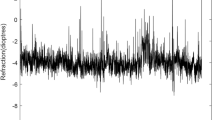Abstract
Purpose: To investigate quantitatively in young adults therelationship between long-term cumulative nearwork, degradation ofdynamic accommodative ability and the presence of asthenopic symptoms. Methods: Subjects consistedof 87 young students and office workers between 18 and 31 years of age with uncorrectedvisual acuity of 20/30 or better in each eye. The amounts of nearwork, dynamic accommodativefacility, and level of asthenopic symptoms were measured for each subject. Results:Total cumulative nearwork time was negatively correlated with accommodative facilityand positively correlated with the number of asthenopic symptoms. Furthermore,significant correlations were found between total nearwork time and blurred vision, andblurred vision and reduced accommodative facility. Moreover, the sub-category of ``hoursspent reading over the years'' was found to be significantly correlated with decreasedaccommodative facility. Conclusions: The correlations suggest a relationship betweencumulative amount of nearwork, decreased accommodative facility and asthenopia.
Similar content being viewed by others
References
Rosenfield M, Gilmartin B. Myopia and nearwork. Oxford, Boston: Butterworth-Heinemann, 1998.
Ong E, Ciuffreda KJ. Accommodation, nearwork, and myopia. Santa Ana, CA: OEP Foundation Press, 1997.
Hung GK. Adaptation model of accommodation and vergence. Ophthalmic Physiol Opt 1992; 12: 319–326.
Ciuffreda KJ, Ordoñez X. Abnormal transient myopia in symptomatic individuals after sustained nearwork. Optom Vis Sci 1995; 72: 506–510.
Hung GK, Ciuffreda KJ. Model of human refractive error development. Curr Eye Res 1999; 19: 41–52.
Mc Brien NA, Adams DW. A longitudinal investigation of adult-onset and adult-progression of myopia in an occupational group. Invest Ophthalmol Vis Sci 1997; 38: 321–333.
Benjamin WJ, ed. Borish's Clinical Refraction. Philadelphia: Saunders, 1998.
Hung GK, Ciuffreda KJ, Semmlow JL. Static vergence and accommodation: Population norms and orthoptics effects. Doc Ophthalmol 1986; 62: 165–179.
Dwyer PS. Clinical criteria for vergence accommodation dysfunction. Clin Exp Optom 1991; 74: 112–119.
Hennessey D, Iosue RA, Rouse MW. Relation of symptoms to accommodative infacility of school-aged children. Amer J Optom Physiol Optics 1984; 61: 177–183.
Siderov J, Johnston AW. The importance of the test parameters in the clinical assessment of accommodative facility. Optom Vis Sci 1990; 67: 551–557.
Levine S, Ciuffreda KJ, Selenow A, Flax N. Clinical assessment of accommodative ability in symptomatic and asymptomatic individuals. J Amer Optom Assoc 1985; 56: 286–290.
Schroeder TL, Rainey BB, Goss DA, Grosvenor TP. Reliability of and comparisons among methods of measuring dissociated phoria. Optom Vis Sci 1996; 73(6): 389–397.
Jiang BC, White JM. Effect of accommodative adaptation on static and dynamic accommodation in emmetropia and lateonset myopia. Optom Vis Sci 1999; 76: 295–302.
Cole BL, Maddocks J, Sharpe K. Effect of VDUs on the eyes: Report of a 6–year epidemiological study. Optom Vis Sci 1996; 73: 512–528.
Wick B, Hall P. Relation among accommodative facility, lag and amplitude in elementary school children. Amer J Optom Physiol Optics 1987; 64: 593–598.
Jackson TW, Goss DA. Variation and correlation of clinical tests of accommodative function in a sample of school-age children. J Am Optom Assoc 1991; 62: 857–866.
Rouse MW. Management of binocular anomalies: Efficacy of vision therapy in the treatment of accommodative deficiencies. Amer J Optom Physiol Optics 1987; 64: 415–420.
Liu JS, Lee M, Jang J, Ciuffreda KJ, Wong JH, Grisham D et al. Objective assessment of accommodation orthoptics: Dynamic insufficiency. Amer J Optom Physiol Opt 1979; 56: 285–294.
Sterner B, Abrahamsson M, Sjostrom A. Accommodative facility training with a long term follow up in a sample of school aged children showing accommodative dysfunction. Doc Ophthalmol 1999; 99: 93–101.
Author information
Authors and Affiliations
Rights and permissions
About this article
Cite this article
Iribarren, R., Fornaciari, A. & Hung, G.K. Effect of cumulative nearwork on accommodative facility and asthenopia. Int Ophthalmol 24, 205–212 (2001). https://doi.org/10.1023/A:1022521228541
Issue Date:
DOI: https://doi.org/10.1023/A:1022521228541




